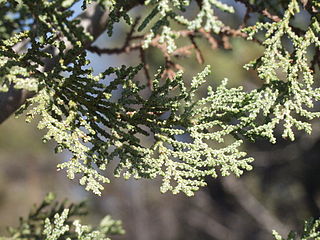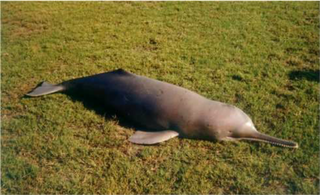
The Chao Phraya is the major river in Thailand, with its low alluvial plain forming the centre of the country. It flows through Bangkok and then into the Gulf of Thailand.

The bull shark, also known as the Zambezi shark in Africa and Lake Nicaragua shark in Nicaragua, is a species of requiem shark commonly found worldwide in warm, shallow waters along coasts and in rivers. It is known for its aggressive nature, and presence mainly in warm, shallow brackish and freshwater systems including estuaries and (usually) lower reaches of rivers. This aggressive nature is a reason for its population being listed as vulnerable on the IUCN Red List. Shark-culling occurs near beaches to protect beachgoers, which is one of the causes of bull shark populations continuing to decrease.

Hesperocyparis bakeri, previously known Cupressus bakeri, with the common names Baker cypress, Modoc cypress, or Siskiyou cypress, is a rare species of western cypress tree endemic to a small area across far northern California and extreme southwestern Oregon, in the western United States.

Hesperocyparis macnabiana is a species of western cypress in from California that was previously named Cupressus macnabiana.

Functional extinction is the extinction of a species or other taxon such that:
- It disappears from the fossil record, or historic reports of its existence cease;
- The reduced population no longer plays a significant role in ecosystem function;
- The population is no longer viable. There are no individuals able to reproduce, or the small population of breeding individuals will not be able to sustain itself due to inbreeding depression and genetic drift, which leads to a loss of fitness.

An endangered species is a species that is very likely to become extinct in the near future, either worldwide or in a particular political jurisdiction. Endangered species may be at risk due to factors such as habitat loss, poaching, and invasive species. The International Union for Conservation of Nature (IUCN) Red List lists the global conservation status of many species, and various other agencies assess the status of species within particular areas. Many nations have laws that protect conservation-reliant species which, for example, forbid hunting, restrict land development, or create protected areas. Some endangered species are the target of extensive conservation efforts such as captive breeding and habitat restoration.
Paraschistura alta is a species of ray-finned fish in the genus Paraschistura from the Helmand River in Afghanistan.
Paraschistura bampurensis, the Bampur loach, is a species of stone loach that is found in Southern Iran and Pakistan, along the Persian Gulf and Gulf of Oman. Its common name refers to the Bampur River.
Paraschistura lepidocaulis is a species of stone loach that is endemic to Pakistan.
Paraschistura lindbergi is a species of stone loach found in Afghanistan and Pakistan.
Kessler's loach, or the Pishin Lora loach, is a species of stone loach found in the countries of Iran, Afghanistan and Pakistan, from the Gulf of Oman to the Caspian Sea.
Paraschistura microlabra is a species of stone loach endemic to Pakistan.
Paraschistura naseeri is a species of stone loach endemic to Khyber Pakhtunkhwa province of Pakistan.
Paraschistura prashari is a species of stone loach endemic to Pakistan.
Paraschistura punjabensis is a species of ray-finned fish in the genus Paraschistura. It is endemic to cold hillstreams of the Salt Range in Punjab, Pakistan.
Paraschistura is a genus of stone loaches most of which occur in Central, South and Western Asia.

The Indus river dolphin is a species of toothed whale in the family Platanistidae. It is endemic to the Indus River basin in Pakistan and Beas River in northwestern India. This dolphin was the first discovered side-swimming cetacean. It is patchily distributed in five small, sub-populations that are separated by irrigation barrages.
Paraschistura chrysicristinae, the Diyarbakır loach or Batman River loach is a species of ray-finned fish in the genus Paraschistura. It was recorded from two locations from the Batman River in the 1970s and had not been recorded since then, until in 2021 when specimens were found in the Han stream and Sarim stream. It is thought that the fish was able to avoid discovery by being so small (3 cm) and thus able to easily slip through nets.

The Sonoran Desert tortoise, or Morafka's desert tortoise, is a species of tortoise native to the Sonoran Desert.

Chaenopsis alepidota, the orangethroat pikeblenny, is a species of chaenopsid blenny found in the eastern Pacific Ocean from California to the Gulf of California. It lives in holes excavated by worms in sandy areas. Some notable distinguishing physical characteristics of the species within the Chaenopsis family are the number of dark lateral blotches and the main body color. The Chaenopsis alepidota species in particular has 11 blotches and has a pale and light green main body color.








